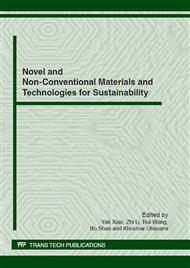p.27
p.34
p.43
p.51
p.63
p.71
p.76
p.81
p.87
Effect of Fiber Gradation on the Edge Bearing Strength of Bamboo Culms
Abstract:
Standardization, and thereby acceptance of any construction material requires years of testing and analysis. For structural bamboo, prototype model standards, in the form of the International Organization for Standardization (ISO) documents on bamboo design, testing and construction are available. While these provide useful guidelines, an important and often overlooked consideration in developing test methods is that these must be usable and reliably repeatable in the environment in which they are most expected likely to be used. The present work investigates the potential for adopting the relatively simple-to-conduct edge bearing test as an indirect means of obtaining the critical, although otherwise difficult-to-obtain transverse material properties. Expanding previous studies on transverse material properties, the research explores the effect of through-culm-wall fiber gradation on the edge bearing, or diametric compression, strength of full-culm bamboo. The test method utilizes a full culm section cut into two or three concentric annular sections. Tests results for each ring provide a measure of through thickness transverse properties. The objective of this work is the development of practical test methods for field assessment of bamboo material properties.
Info:
Periodical:
Pages:
63-70
Citation:
Online since:
June 2012
Authors:
Keywords:
Price:
Сopyright:
© 2012 Trans Tech Publications Ltd. All Rights Reserved
Share:
Citation:


